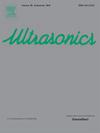利用超声喷丸诱导梯度纳米结构提高254SMo超奥氏体不锈钢焊缝的耐高温氧化性
IF 4.1
2区 物理与天体物理
Q1 ACOUSTICS
引用次数: 0
摘要
采用超声喷丸工艺(USP)对254SMo不锈钢焊缝表面进行强化,制备了梯度纳米结构,并对其表面性能和不同温度下的高温氧化性能进行了研究。通过对USP处理后焊缝表面形貌、显微组织、残余应力和显微硬度的研究,研究了USP处理后样品在700、800和900℃下的抗高温氧化性。讨论了USP处理提高254SMo不锈钢焊缝高温氧化性能的可能影响机理。结果表明:采用USP在254SMo不锈钢焊缝表面制备了梯度纳米结构,焊缝残余压应力和最大显微硬度分别为- 496.37 MPa和357.5 HV;在700℃和800℃时,焊缝表现出较好的抗氧化性,而在900℃时,由于大量MoO3的生成,氧化很强烈。在700℃、800℃和900℃时,氧化反应速率常数分别降低了61.3%、55%和63.8%,形成了较厚的氧化保护膜。这是因为晶粒细化产生的大量晶界促进了Cr2O3的形成,抑制了MoO3的生成。研究表明,用USP法制备的梯度纳米结构是提高材料高温抗氧化性能的有效方法。本文章由计算机程序翻译,如有差异,请以英文原文为准。
Improving the resistance to high-temperature oxidation of 254SMo super-austenitic stainless steel welds using ultrasonic shot peening-induced gradient nanostructures
This paper reported the strengthening of the surface of 254SMo stainless steel welds by the ultrasonic shot peening process (USP) to prepare gradient nanostructures, and their surface properties and high-temperature oxidation performance at different temperatures were explored. After investigating the surface morphology, microstructure, residual stress, and microhardness of the welds after USP, the resistance towards high-temperature oxidation of the samples processed by USP at 700, 800, and 900°C was studied. Also discussed were the possible influence mechanisms of the high-temperature oxidation properties of 254SMo stainless steel welds enhanced by USP processing. The results showed the preparation of gradient nanostructures on the surface of 254SMo stainless steel welds using USP and the residual compressive stress and maximum microhardness at the weld were −496.37 MPa, and 357.5 HV respectively. At 700°C, 800°C welds show better oxidation resistance, while at 900°C due to a large number of MoO3 generation, oxidation is intense. At 700°C, 800°C, and 900°C, the oxidation reaction rate constants decreased by 61.3 %, 55 %, and 63.8 % respectively, and a thick protective oxide film was formed. This is because a large number of grain boundaries generated by grain refinement promoted the formation of Cr2O3 and inhibited the generation of MoO3. The study shows that the gradient nanostructures prepared by USP are an effective method for improved oxidation resistance of materials at high temperatures.
求助全文
通过发布文献求助,成功后即可免费获取论文全文。
去求助
来源期刊

Ultrasonics
医学-核医学
CiteScore
7.60
自引率
19.00%
发文量
186
审稿时长
3.9 months
期刊介绍:
Ultrasonics is the only internationally established journal which covers the entire field of ultrasound research and technology and all its many applications. Ultrasonics contains a variety of sections to keep readers fully informed and up-to-date on the whole spectrum of research and development throughout the world. Ultrasonics publishes papers of exceptional quality and of relevance to both academia and industry. Manuscripts in which ultrasonics is a central issue and not simply an incidental tool or minor issue, are welcomed.
As well as top quality original research papers and review articles by world renowned experts, Ultrasonics also regularly features short communications, a calendar of forthcoming events and special issues dedicated to topical subjects.
 求助内容:
求助内容: 应助结果提醒方式:
应助结果提醒方式:


